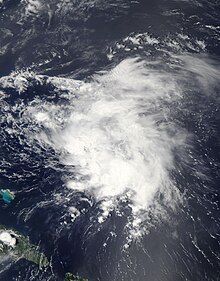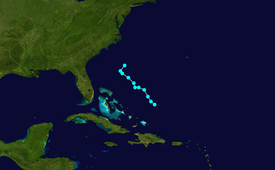Tropical Storm Danny (2009)
It has been suggested that this article be merged into 2009 Atlantic hurricane season. (Discuss) Proposed since February 2024. |
 Tropical Storm Danny intensifying off the Bahamas on August 26 | |
| Meteorological history | |
|---|---|
| Formed | August 26, 2009 |
| Dissipated | August 29, 2009 |
| Tropical storm | |
| 1-minute sustained (SSHWS/NWS) | |
| Highest winds | 60 mph (95 km/h) |
| Lowest pressure | 1006 mbar (hPa); 29.71 inHg |
| Overall effects | |
| Fatalities | 1 direct |
| Damage | Minimal |
| Areas affected | North Carolina, Northeastern United States and Atlantic Canada |
| IBTrACS | |
Part of the 2009 Atlantic hurricane season | |
Tropical Storm Danny was a weak and disorganized
Danny had only minor effects on land. However, it triggered high surf and rip currents from
Meteorological history

Tropical storm (39–73 mph, 63–118 km/h)
Category 1 (74–95 mph, 119–153 km/h)
Category 2 (96–110 mph, 154–177 km/h)
Category 3 (111–129 mph, 178–208 km/h)
Category 4 (130–156 mph, 209–251 km/h)
Category 5 (≥157 mph, ≥252 km/h)
Unknown
Danny originated in a
Due to the interaction of the initial wave and the upper-level trough, Danny maintained a "non-classical" structure resembling that of a subtropical cyclone.[1] Even after its designation as a tropical storm, the storm was highly disorganized. Little or no deep thunderstorm activity surrounded the center, and the highest winds were confined to a rainband in the northern semicircle of the cyclone.[2] The storm moved erratically northwestward throughout the day on August 26, strengthening only slightly.[1] Danny's center reformed several times, making it difficult to determine its direction of movement.[3]
By early on August 27, the tropical storm became slightly better organized, although the most intense winds were still removed from the center.

A strong upper-level trough moving through the southeastern United States forced Danny northeastward. It also triggered the formation of another low pressure system near the coast of North Carolina early on August 29. Although this low formed within Danny's cyclonic envelope, satellite imagery indicated that it did not have the characteristics of a tropical cyclone. Therefore, it is not considered to be a continuation of Danny. The new low caused the tropical storm to degenerate into a trough about 275 mi (445 km) southeast of Wilmington, North Carolina, and Danny's remnants were absorbed into a developing frontal zone shortly thereafter.[1]
Impact
In advance of the cyclone, a
As the storm remained offshore, its effects were limited. However, it generated strong rip currents and high waves along the
The remnants of the storm interacted with a
Danny's remnants later caused heavy rain across Atlantic Canada. At Saint John, New Brunswick, 100 mm (3.9 in) of rain flooded at least 50 basements. The Meteorological Service of Canada hoisted several weather advisories for New Brunswick, Newfoundland, Prince Edward Island and Nova Scotia.[20][21] In Nova Scotia, over 16,000 residences lost power at the height of the storm.[22]
See also
- Timeline of the 2009 Atlantic hurricane season
- List of North Carolina hurricanes (2000–present)
- List of New England hurricanes
- List of Canada hurricanes
- Other storms of the same name
References
- ^ a b c d e f g John L. Beven (January 6, 2010). "Tropical Storm Danny Tropical Cyclone Report" (PDF). National Hurricane Center. Retrieved January 12, 2010.
- ^ Forecaster Beven (August 26, 2009). "Tropical Storm Danny Discussion Number 2". National Hurricane Center. Retrieved January 12, 2010.
- ^ Forecaster Blake (August 27, 2009). "Tropical Storm Danny Discussion Number 4". National Hurricane Center. Retrieved January 12, 2010.
- ^ Forecaster Beven (August 27, 2009). "Tropical Storm Danny Discussion Number 5". National Hurricane Center. Retrieved January 12, 2010.
- ^ Forecaster Avila (August 28, 2009). "Tropical Storm Danny Discussion Number 8". National Hurricane Center. Retrieved January 12, 2010.
- ^ Forecaster Brennan (August 28, 2009). "Tropical Storm Danny Discussion Number 10". National Hurricane Center. Retrieved January 12, 2010.
- ^ Jeff Hampton and Patrick Wilson (August 29, 2009). "Coast Guard ends search for boy missing off Corolla". The Virginian-Pilot.
- ^ Paul Cox (September 1, 2009). "Authorities find body of N.Y. boy who disappeared along N.C. coast". The Star-Ledger. Retrieved December 9, 2009.
- ^ "Event Record Details for Florida: High Surf". National Climatic Data Center. 2009. Retrieved December 9, 2009.[permanent dead link]
- ^ "Event Record Details for Delaware: High Surf". National Climatic Data Center. 2009. Retrieved December 9, 2009.[permanent dead link]
- ^ "Event Record Details for New Jersey: High Surf". National Climatic Data Center. 2009. Retrieved December 9, 2009.[permanent dead link]
- ^ "Event Record Details for Pennsylvania: Flash Flood". National Climatic Data Center. 2009. Retrieved December 9, 2009.[permanent dead link]
- ^ "Event Record Details for Pennsylvania: Flood". National Climatic Data Center. 2009. Retrieved December 9, 2009.[permanent dead link]
- ^ "Event Record Details for Pennsylvania: Flash Flood". National Climatic Data Center. 2009. Retrieved December 9, 2009.[permanent dead link]
- ^ "Event Record Details for New Jersey: Flash Flood". National Climatic Data Center. 2009. Retrieved December 9, 2009.[permanent dead link]
- ^ "Event Record Details for Maryland: Flash Flood". National Climatic Data Center. 2009. Retrieved December 9, 2009.[permanent dead link]
- ^ "Even Record Details for Massachusetts". National Climatic Data Center. 2009. Retrieved December 9, 2009.[permanent dead link]
- ^ "Event Record Details for North Atlantic to Canada: Marine High Wind". National Climatic Data Center. 2009. Retrieved December 9, 2009.[permanent dead link]
- ^ "Event Record Details for Maine: High Wind". National Climatic Data Center. 2009. Retrieved December 9, 2009.[permanent dead link]
- ^ The Canadian Press (August 30, 2009). "Remnants of Danny bring wind, rain to N.L. after moving through Cape Breton". The Cape Breton Post. Archived from the original on September 9, 2018. Retrieved December 9, 2009.
- ^ Forecaster Campbell (August 29, 2009). "Hurricane Danny Information Statement". Canadian Hurricane Centre. Archived from the original on June 11, 2011. Retrieved January 13, 2010.
- ^ The Canadian Press (August 30, 2009). "Post-tropical storm Danny moving across Cape Breton". The Cape Breton Post. Archived from the original on September 9, 2018. Retrieved December 9, 2009.
External links
- Advisory archive for Tropical Storm Danny
- List of bulletins from the Canadian Hurricane Centre
